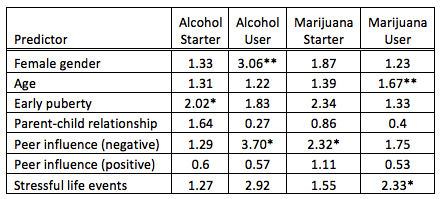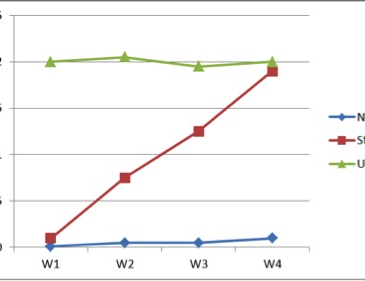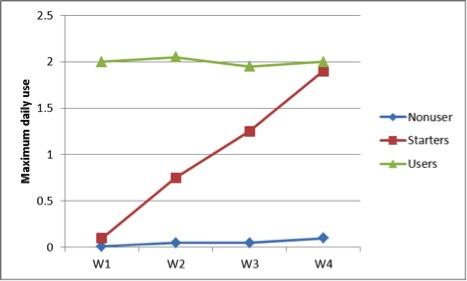Substance use disorders occur at a higher rate among American Indians than other groups in the United States (Wu et al. 2011). Unfortunately, there is very little research focusing on substance use risk in American Indian youth. This week, as part of our Special Series on Addiction and Recovery among Tribal Communities, STASH reports on a recent longitudinal study on common substance use trajectories and risk factors among American Indian adolescents (Whitesell et al. 2014). By studying substance use trajectories, the authors hope to gain a better understanding of how adolescent substance use changes over time and how certain risk factors can predict usage patterns.
Methods
- Researchers surveyed middle-school students on an American Indian reservation in the Northern Plains each semester from spring 2006 to spring 2009. (They achieved a 71% response rate at Wave 1; they did not report the retention rate). For this study, the researchers analyzed a random subset of the data collected during the first four waves (W1: spring 2006, W2: fall 2006, W3: spring 2007, W4: fall 2007; N=381).
- The survey assessed frequency of alcohol, marijuana, and cigarette use. For this STASH, we will focus on alcohol and marijuana use.
- The survey also measured stressful life events, early puberty, peer influences (positive and negative), parent-child relationship, and cultural identity.
Results
- The researchers created 3-class trajectory models1 for alcohol and marijuana use. (Figure 1 included for illustrative purposes). For both alcohol and marijuana use,
- Individuals in the “Nonuser” class reported little or no use in W1 and maintained similar levels of nonuse through W4.
- Individuals in the “Starter” class reported little or no use in W1 with steadily increasing amount of use through W4.
- Individuals in the “User” class reported the higher levels of use in W1 and their use stayed consistent through W4.
Figure. Illustrative trajectories of Nonuser, Starter, and User classes. (Figure does not represent actual values; adapted from Whitesell et al. 2014.) Click image to enlarge.
- Odds ratios indicated factors associated with elevated risk for membership in the User and Starter classes (Table 1).
- Females and those students with negative peer influences were more than 3 times more likely to be Alcohol Users, and students experiencing early puberty were twice as likely to be in the Alcohol Starters.
- Older aged students were 1.7 times more likely to be in Marijuana Users and students who reported stressful life events were more than twice as likely to be Marijuana Users.
- Students who reported negative peer influence were more than twice as likely to be Marijuana Users.
- While positive peer influences showed some association with lower risk of being Alcohol and Marijuana Starters and USers, the effects were not significant when considering other covariates.
- Cultural identity was not associated with alcohol or marijuana use.

Figure. Odds ratios for each substance use class. The Nonuser class served as a reference (adapted from Whitesell et al. 2014; *p < 0.01; ** p < 0.001). Click image to enlarge.
Limitations
- Data were from a single reservation (i.e., rural, dry, with high rates of substance use and disorder), which means that the results might not be generalizable to the entire American Indian population.
- The study participants were in early adolescence, and substance use trajectories might change in later adolescence.
- The study does not have data on non-tribal youth, which limits any direct comparison and generalizability to typical youth.
- The researchers suggest that difficulty measuring cultural identity might have accounted for the lack of an observed relationship between cultural identity and substance use trajectories.
Conclusion
This study revealed that many factors relate to substance use in American Indian adolescents. Generally, older age, early puberty, negative peer influences, and stressful life events corresponded to substance use. Female gender also predicted substance use. This is surprising, given previous findings revealing higher rates of substance use among males (Whitesell et al. 2007). Because American Indian populations experience higher rates of substance use, it is important to identify effective avenues of treatment and paths to resilience. Understanding substance use trajectories and their correlates can be useful in this effort. More specifically, findings such as these can help identify (1) adolescents for whom preventative efforts might be most effective, such as those who are exposed to significant life stresses and those who experience early puberty, and (2) optimal timing for deploying such efforts.
– Jed Jeng
What do you think? Please use the comment link below to provide feedback on this article.
References
Whitesell, N. R., Asdigian, N. L., Kaufman, C. E., Crow, C. B., Shangreau, C., Keane, E. M., … & Mitchell, C. M. (2014). Trajectories of substance use among young American Indian adolescents: Patterns and predictors. Journal of youth and adolescence, 43(3), 437-453.
Whitesell, N. R., Beals, J., Mitchell, C. M., Spicer, P., Novins, D. K., & Manson, S. M. (2007). Disparities in drug use and disorder: comparison of two American Indian reservation communities and a national sample. American journal of orthopsychiatry, 77(1), 131.
Wu, L. T., Woody, G. E., Yang, C., Pan, J. J., & Blazer, D. G. (2011). Racial/ethnic variations in substance-related disorders among adolescents in the United States. Archives of General Psychiatry, 68(11), 1176-1185.
________________
[1] Researchers compared one-, two-, three-, and four-class models using growth mixture modeling, and the 3-class model provided the best fit for each substance.





